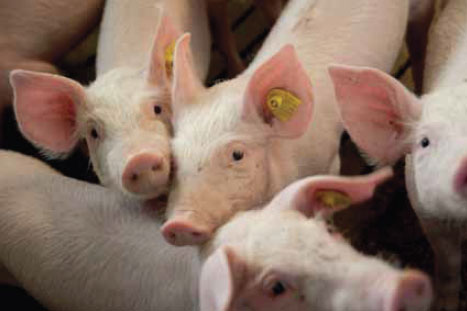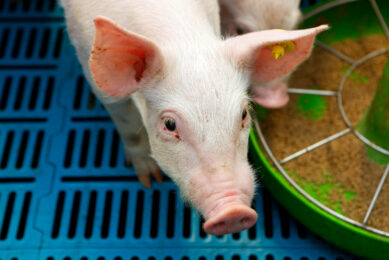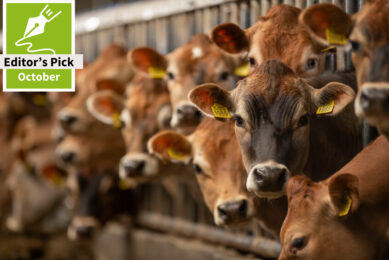Phytogenics in sow feed:One more piglet weaned

Every year steps are being taken to find methods for raising pigs entirely without the use of antibiotics. In this process, the health of mother sows is not forgotten. Influencing her health status directly impacts her capacity for weaning higher amounts of piglets, as this article shows.
The vast majority of phytogenic feed additives (PFA) are classified according to the Regulation (EC) No 1831/2003 of the European Parliament and the Council under the category Sensory Additives and assigned to the functional group of flavouring substances. Phytogenic feed additives are flavours of a new generation, in contrast to conventional flavours used in pig farming especially in piglet feed. Known also as ‘bio-functional flavours’, they not only influence the smell and taste of feed but also trigger a number of processes in the animal such as having an influence on digestibility and absorption of feed ingredients. These functional flavours have also been shown to stabilise the physiological microbiota in the digestive tract and reduce inflammatory processes in the intestinal epithelium.
Scientific studies conducted at research facilities in Thailand and Slovakia on the use of a standardised blend of herbs, spices, plant extracts and essential oils (Digestarom Sow, Biomin) in lactation feed showed increased daily feed intake (> 0.5 kg) and daily milk production (up to 1.5 l), improved piglet growth, higher uniformity and greater number of weaned piglets per litter (>0.5), as shown in Table 1.
In addition to the aforementioned results, it was demonstrated that the blend has a positive impact on sow milk quality, particularly immediately after farrowing, as well as on subclinical inflammatory processes in the mammary glands.
Further studies suggested that using the product only in lactation feed contributes to improved performance parameters, but its true potential will be ensured only when used throughout the entire, as well as over several, reproduction cycles.
There has also been a need for clarification if relevant performance improvements could be achieved with the help of this bio-functional flavour, in practice and on a performance range of 28 to 30 weaned piglets per sow per year.
Field application
Since June 2010, the PFA has been used in the feed of pregnant and lactating sows at a facility in Brandenburg (1,200 sows). The production data saved in the sow planner were made available through colleagues of the Brandenburg Pig Performance Monitoring and Specialized Consultancy Association (BSSB).
The current data describes the influence of this feed additive on the performance data of sow herds over an extended period. The performance of the first reproduction cycle in which the product was used is compared to the subsequent reproduction cycles (Figure 1).Compared with the initial application, further improvements in all recorded parameters were attained in the subsequent reproduction cycles, observed over a period of more than 13 months. In particular, the improved farrowing rate contributed to 1.2 more weaned piglets per sow per year.
Sow fertility and performance
How the product affects sow fertility and performance persistence is shown by means of the Piglet Index (number of live born piglets/100 mated sows) for each parity number (Figure 2). Comparing data from the Rhenish Quality Piglet Producers Association (RQPPA), the trial unit data showed a marked smaller decline in fertility with higher parity numbers. Due to the positive integral effects of the PFA used, the sows were able to capitalise on their overall genetic potential thus achieving maximum production.
The impact of the product on sow fertility is also shown from ongoing studies in cooperation with the Thuringia State Institute for Agriculture in Jena (Germany), at a large scale facility (>9.000 sows) where in the period of one year, the selection of sows due to fertility issues was reduced by 37%. For the practitioner, the ability to repeat results obtained in scientific studies or field tests is an essential quality criterion.
In mid-2010, a trial using the PFA in a commercial facility with 280 sows was conducted in cooperation with the agricultural chamber Warendorf in North Rhine Westphalia, Germany. Performance data of the fiscal year 2010/2011 in which the product was used was compared with those of prior fiscal years as shown in Figure 3.
Outlook
It was shown that the continuous use of the phytogenic feed additive in practice leads to improvements in sow performance to yield an expected average of one additional piglet per sow per year. Inclusion of the product enables the sows to better reach their genetic performance potential, increases performance persistence in higher parity numbers and ultimately enhances live production performance.
The profitability of sow husbandry business is not only positively impacted through the improved number of weaned piglets per sow per year, but also by the possible reduction in replacement rate. To facilitate the benefits presented here required an expense of less than €4 per sow per year. PPReferences available on request.
caption: The number of piglets in practice was seen to grow when using a phytogenic feed additive in sow nutrition.











